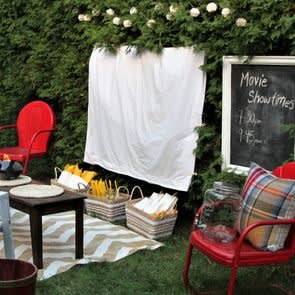4th of July Fireworks: A Complete Guide
One of the big highlights of the summer is seeing 4th of July fireworks. The bright pops of color in the sky paired with barbecues, all things red, white, and blue, and friends and family make for the perfect celebration. As you start to come up with ideas for the 4th of July, you might be considering going to see one of the best fireworks displays in the country or buying your own fireworks to set off at home. Before deciding on your holiday game plan, learn all about fireworks in the guide below for an amazing—and safe—celebration.
Why do we celebrate the 4th of July with fireworks?
Haven’t you always wondered why it’s a tradition to set off explosions of light in the sky on Independence Day? It’s certainly a day for celebration, but why fireworks? Well, the 4th of July’s history actually involves fireworks and you can thank famous historian John Adams for it.
During the first months of the Revolutionary War, after the 13 colonies had all voted in favor of independence from Britain, Congress began to write a declaration, which became the Declaration of Independence. Before it was even finished and signed, an enthusiastic John Adams wrote his wife a letter about how he thought the occasion of America’s freedom should be celebrated. It read:
“The Second Day of July 1776, will be the most memorable Epocha, in the History of America. I am apt to believe that it will be celebrated, by succeeding Generations, as the great anniversary Festival…It ought to be solemnized with Pomp and Parade, with Shews, Games, Sports, Guns, Bells, Bonfires and Illuminations from one End of this Continent to the other from this Time forward forever more.”
Adams was off by a few days, but the 4th of July was most certainly celebrated in a way he would have liked.
The first organized 4th of July fireworks were set off in 1777 in Pennsylvania and Boston (Adams’ hometown) one year after the Declaration of Independence was signed. The Pennsylvania Evening Post reported that “the evening was closed with the ring of bells, and at night there was a grand exhibition of fireworks (which began and concluded with thirteen rockets) on the Commons, and the city was beautifully illuminated.” Boston still has one of the most spectacular fireworks shows on the Fourth, and its unique history definitely plays a part in that. In the years following, many more cities took part in July 4th celebrations that included speeches, parades, and picnics, in addition to fireworks.
Boston showed its love for the Fourth again when the city was the first to designate July 4th as an official holiday in 1783. Then, in the 1800s, fireworks started to become available to the public and the sky became even more illuminated on the big day. And in 1870, Congress followed, making Independence Day a federal holiday. The bright colors and loud bangs are the perfect way to celebrate America’s freedom year after year.
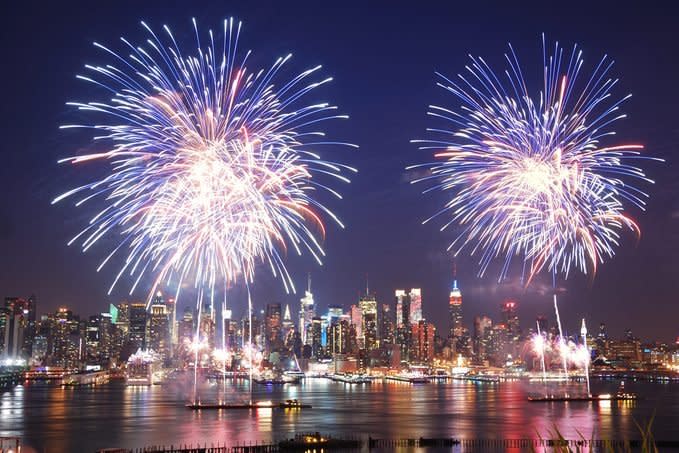
Where to see the best fireworks on the 4th of July
If you want to see a big 4th of July fireworks display this year, there are a few around the country that are sure to impress, whether you’re staying close to home or going on an Independence Day getaway.
New York City: Macy’s 4th of July Fireworks
Every year, the Big Apple puts on the largest fireworks show in the country. Thousands of fireworks are set off from barges lining the Hudson River, and the lights show is accompanied by music from the New York Pops Orchestra and Mormon Tabernacle Choir. The best viewing spots are along the West Side Highway below 59th Street or, if you’re on the New Jersey side, anywhere along the waterfront in Weehawken and Hoboken. Or, of course, you can watch the broadcast on NBC.
Boston: Boston Pops Concert Fireworks Spectacular
Thousands gather along the Charles River in Boston for the city’s annual 4th of July spectacular. The Boston Pops kick things off at 8 p.m. with the national anthem and a patriotic sing-a-long. The fireworks start at 10:30 p.m. The best view is from the Esplanade along the Charles River, but if you want to avoid the crowds, you can watch the show from across the river in Cambridge.
Philadelphia: Wawa Welcome America
What better place to celebrate the 4th of July than right near the Liberty Bell and Independence Hall in Philadelphia? There’s a concert and parade during the day, and the fireworks start at 10:30 p.m. at the Philadelphia Museum of Art.
St. Louis: Fair St. Louis Fourth of July Fireworks Spectacular
After a COVID-related break last year, St. Louis is raring to go in 2021 with its traditional fireworks display over the Mississippi and the Gateway Arch. The only difference? This year, there will be 3,000 shells being set off from three barges and lots of patriotic music. The show will start around 9:40 p.m.
Washington, D.C.: A Capitol Fourth Concert
If you’re in our nation’s capital for the 4th of July, check out the fireworks show launched from the Lincoln Memorial Reflecting Pool, a little after 9 p.m. Watching the bright lights illuminate the sky behind the Washington Monument is truly a sight to see. Just a note, though, that the concert that usually takes place on the West Lawn of the U.S. Capitol Building will be pre-taped this year and air on PBS.
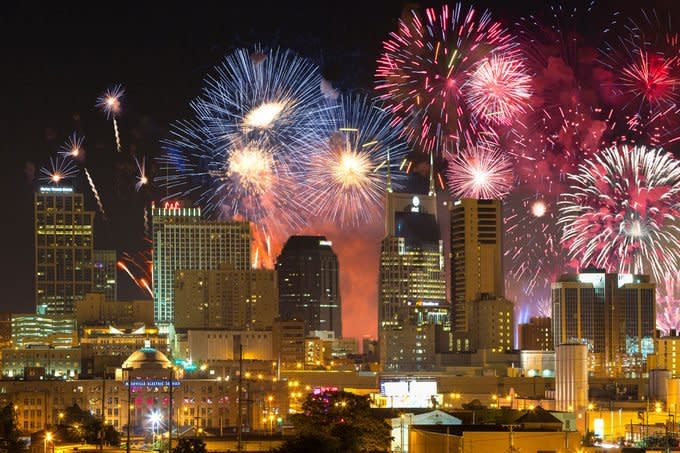
Nashville: Let Freedom Sing!
Since last year’s celebration was canceled due to the pandemic, organizers decided to make this July 4th celebration bigger than ever with the largest fireworks show in Nashville history. Along with the fireworks, there will be a synchronized performance by the Grammy-winning Nashville Symphony. Music fans will not want to miss this. If you’re making your own playlist for the rest of the holiday weekend, load it up with these 4th of July songs.
Tampa: Boom by the Bay
One fireworks show is cute…but six make for a serious celebration. Tampa will host a whopping six fireworks displays along its downtown waterfront, and before the big show (which will start around 9:15), you’ll get to enjoy plenty of family-friendly activities, live entertainment, and a boat parade.
Atlanta: The Fantastic Fourth Celebration at Stone Mountain Park
Atlanta doesn’t mess around when it comes to its 4th of July celebrations. While the regular show at Centennial Olympic Park won’t be happening this year, the display at Stone Mountain Park will make up for it. You’ll be treated to a laser light show at dusk before the big fireworks display—and not just on the big day. You can enjoy the fun for five nights, between July 1 and July 5.
Houston: Freedom Over Texas
Everything really is bigger in Texas, and the Lone Star State proves that with its annual Independence Day fireworks show, which is the largest land-based fireworks show in the entire United States. The show is set off from Buffalo Bayou in Eleanor Tinsley Park, just west of Sabine Bridge and the downtown area. This year, you’ll be able to see more of it from farther away: The fireworks will reach a whopping 800 feet, which is more than double what it normally is.
Las Vegas: Fireworks on the Strip
Step away from the slot machines (for at least a few minutes) for this massive patriotic display in Sin City. This year, seven hotels on the Las Vegas Strip will coordinate fireworks displays starting at 11 p.m. Yes, it’s late, but remember, it’s Vegas.
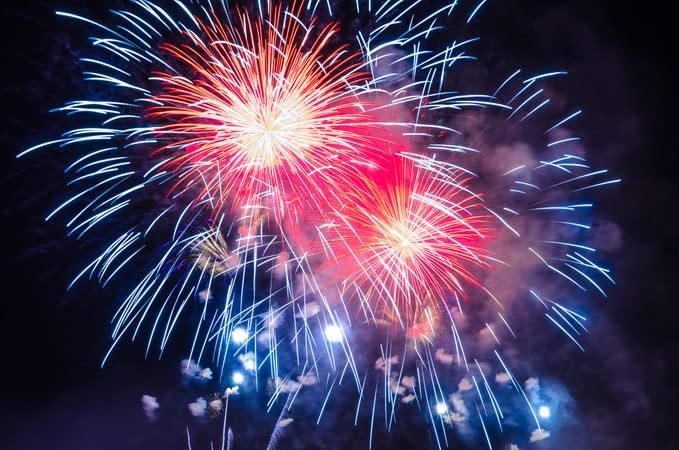
Fireworks safety
If you choose to forgo the big fireworks displays around the country and want to set off your own, know that fireworks are no joke. All fireworks and sparklers can be dangerous when not used correctly. According to the 2020 CPSC fireworks safety report, there were an estimated 7,300 injuries just in the one month surrounding the 4th of July in 2019, and about 2,600 of those injuries happened to kids 14 years old and younger.
So, what do you need to know to make your festivities as safe as possible? For starters, don’t set fireworks off near your house—and that includes off your deck. That’s just too close and could start a fire. Instead, fireworks should be lit away from buildings and on a flat, level, hard, and fireproof surface, away from debris like trash or vegetation that could catch on fire. Also, don’t light fireworks under power lines or near anything combustible, like a propane tank. Plus, you’ll want to plan for emergencies, just in case: Keep a bucket full of water close by and a garden hose. Be sure to turn the faucet on and ensure the water is running to the hose so you can put out a fire immediately. Here’s what else you should keep in mind:
Adult supervision is a must
When it comes to fireworks and children, the CPSC makes it pretty clear: Never allow young children to play with or ignite fireworks. Even sparklers, which kids have been waving around for hundreds of years, are quite dangerous. When you get down to it, it’s a very pointy object that burns as hot as a blow torch—about 2,000 degrees. “Extreme care must be practiced when sparklers are used, and only under close adult supervision,” says Julie Heckman, executive director at American Pyrotechnics Association (APA). Sparkler injuries accounted for about 500 injuries in tots five years old and younger. Something that’s a lot safer? Having kids make fireworks-inspired 4th of July crafts.
Dress for the occasion
If you’re going to set off fireworks, don’t do it barefoot or with minimal protection; Heckman suggests closed-toe shoes. You should also don safety glasses to protect your eyes, keep long hair pulled back, and avoid clothes with loose or hanging fabric that could catch fire. If possible, use a utility-style lighter for a safer distance between your arm and the fuse. Also, absolutely do not smoke while around fireworks.
Be alert and sober
Barbecues and beer go hand in hand on the Fourth, but if you don’t want to lose a hand (or hurt someone else), don’t drink and set off fireworks. An incident in the CPSC report tells of a 61-year-old man who died after lighting a firework the wrong way, causing it to hit him in the chest. He had been drinking during the day, and police found many empty alcohol containers at the scene. And spectators, listen up: You should be careful when it comes to drinking alcohol around fireworks displays, too.

Pet care
Keep your pets inside. Even if they aren’t afraid of the noise or lights, a dog or cat’s curiosity about the fireworks could get them hurt or they could accidentally end up in the path of the fireworks.
Check the weather
The weather is actually a significant factor in firework safety, and it’s not just rain that can dampen the festivities. Windy conditions aren’t safe for lighting fireworks because fireworks can tip over or the wind could send them in the path of spectators or passersby. And always light fireworks with the prevailing wind blowing away from the spectators.
Keep spectators safe
Spectators should be watching 4th of July fireworks from a safe distance. Heckman says for fountain and cone fireworks, spectators should be at least 25 feet away, and for aerial fireworks, at least 40 feet away. Remember: Each state and municipality has specific laws regarding fireworks, so make sure to read up on the specifics ahead of time.
Never do these things with fireworks
You know what they say about an ounce of prevention. These tiny tips can go a long way in warding off ER visits—or worse.
Don’t shoot fireworks from a metal or glass container.
Never aim them at another person.
Don’t carry them in your pocket.
Never place any part of your body directly over a firework device.
Never bundle fireworks for a bigger bang. It be might be tempting to combine fireworks or take them apart to make your own creation, but the CPSC strongly advises against this.
Don’t relight a firework that didn’t go off the first time; it still could go off and explode.
If you see a firework on the ground, leave it. There’s no telling why it’s on the ground. Report it to the police or fire department. If you’re a parent, be sure to warn your kids of this danger.
Don’t be in a rush to pick up spent fireworks. Let them stand for at least 20 minutes before you pick them up or you could get burned. Next, submerge all the fireworks in a bucket of water and let them soak overnight. (The same goes for duds, but to be extra safe, scoop them up with a shovel and then submerge them in water.) Once you follow those steps, you can place the soaked fireworks in a trash bag and dispose of them with your other household trash.
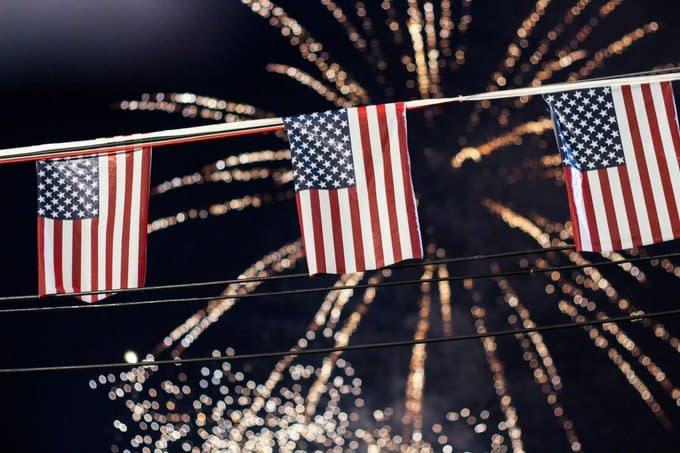
Where are fireworks legal?
Because of the risks that come along with setting off fireworks, many states have strict regulations on them. The only state that completely bans all consumer fireworks is Massachusetts. Ohio, Illinois, and Vermont only allow wire or wood stick sparklers and a few other novelty items. The remaining 46 states and Washington, D.C., allow consumer fireworks in some form. The restrictions vary from state to state, though, so before buying and setting off 4th of July fireworks, make sure to look up your local laws. Here’s more about the types of fireworks that are illegal in certain states.
Where to buy fireworks
Again, where you can buy fireworks is going to depend a lot on where you live. If you’re looking for something small, like sparklers, those can typically be found at your local department or grocery store. Larger fireworks are typically sold from firework stores, online, or from roadside stands that start to pop up around the Fourth. Before purchasing any fireworks, read up on your local laws and the safety tips noted above. Too worried about the dangers of fireworks to attempt an at-home display? Try these 4th of July games the whole family will love instead.
Fun facts about fireworks
Those 4th of July fireworks displays look a lot like magic, but they actually entail a lot of science and some very specific planning. Here’s how it all works:
It’s amazing how a firework can end up looking like a chrysanthemum or smiley face when it has only three main components—an oxidizer, a fuel, and a chemical mixture to produce the color. The ingredients are placed in a small tube called an aerial shell. The explosive materials are called stars, and they form the colorful spheres, cubes, cylinders, and other shapes that explode into complex designs.
To get fireworks into the air, the aerial shells are placed in a tube called a mortar. Fireworks staff light a fast-acting fuse below the shell that contains gunpowder, and the gunpowder explodes, creating a buildup of heat and gas and a whole lot of pressure. When the pressure reaches critical mass, off it goes up into the sky. But that’s not the end. Once the shell is high off the ground, another fuse inside the aerial shell that’s on a time delay ignites, causing the bursting charge to explode and light up all those stars you see from the ground.
How do the components in a cylinder end up looking like a heart, a smiley face, or an acronym? They are created in an aerial shell with embedded colored stars laid out in a pattern of the desired shape. There’s filler in between the stars—usually a quickly burning composite that is light and doesn’t compete with the stars. The stars with greater mass travel farther than the lighter stars.
Brilliant, glowing colors come from different metal elements. When the chemicals in fireworks burn, energy is released in the form of light. The chemicals burn in different wavelengths of light depending on the metal element. For example, deep reds are the result of burning strontium and lithium compounds; barium gives off a green color; and copper produces blues. Blue, however, is a fickle hue and considered the most difficult to produce because the copper compound has to be heated just right to make it work. If it burns too hot, the color is lost, and if it’s too low, there’s no intensity.
After a firework expends itself, the remaining debris is biodegradable paper and a small amount of carbon.
Now that you know all about fireworks, there’s just one thing left to do: Find the perfect 4th of July captions for them and for all of your other patriotic pics!
Sources:
Massachusetts Historical Society: “Letter from John Adams to Abigail Adams, 3 July 1776, ‘Had a Declaration…'”
History: “Fourth of July—Independence Day”
Julie Heckman, executive director at the American Pyrotechnics Association (APA)
CPSC: “Fireworks-Related Deaths, Emergency Department-Treated Injuries, and Enforcement Activities During 2019”
Picture-Perfect 4th of July Desserts
Patriotic Quotes to Honor America
Patriotic Movies to Watch on the 4th
The post 4th of July Fireworks: A Complete Guide appeared first on Reader's Digest.


